Reaping the Rewards is a series looking at finished products that were originally crowdfunded. Today’s topic: Pyramid Arcade, which was funded by Looney Labs on Kickstarter in May 2016. The project hit its initial funding goal in under 12 hours, and went on to raise $150k from over 2,000 backers. It was shipped to backers in fall 2016, and became available in retail in November 2016.
Pyramid Arcade isn’t a single game: it’s a game system. The Looney Pyramids (formerly called Icehouse or Treehouse Pyramids) have been around for a while now, and there are hundreds of games you can play with them—some with just the pyramids, some with chessboards or cards, and some with customized dice or other accessories. Pyramid Arcade collects everything you need to play the majority of these games in one box, along with a rulebook that teaches you how to play 22 of them. The retail price is $77.
Looney Labs sent me one of their advance copies to preview, so let’s take a look at what’s in the box!
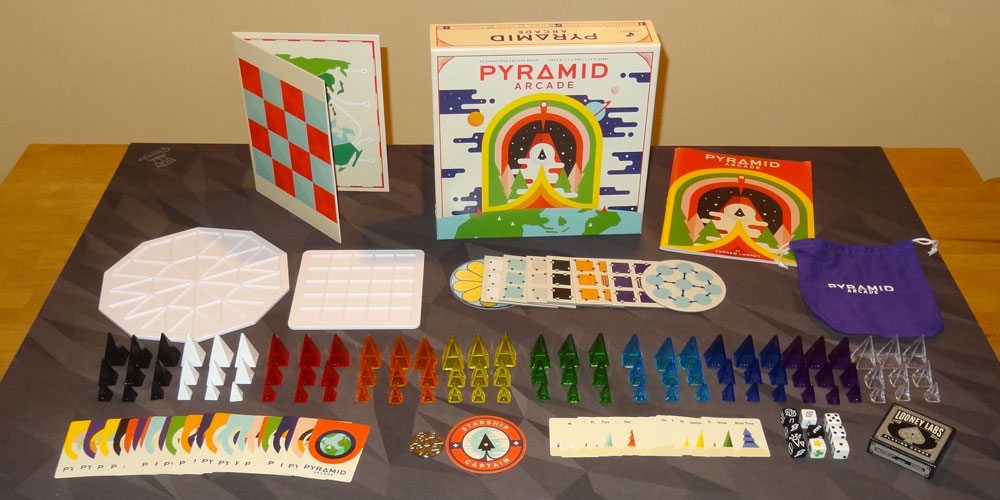
The Pyramid Arcade comes in a large square box, which has a stylized image on the cover that has a nice retro feel to it. Inside the box, you’ll find a few things layered on top of the box insert: a big 75-page booklet, a folding board, and two plastic boards. Underneath those is a plastic insert that holds everything else: 90 pyramids, 9 dice, 8 mini gameboards, a square deck of cards, some Twin Win cards, the Pyramid Arcade cards, a drawstring bag, a turn token, and a Starship Captain sticker. It’s a lot to fit in there, but the tray holds all the pyramids nicely. Of course, if you pledged for the Kickstarter-exclusive green pyramids like I did, you’ll have to find some place to fit them, because the well that holds the cards and dice and mini-boards is already pretty full. (I may end up putting some things underneath the insert.)
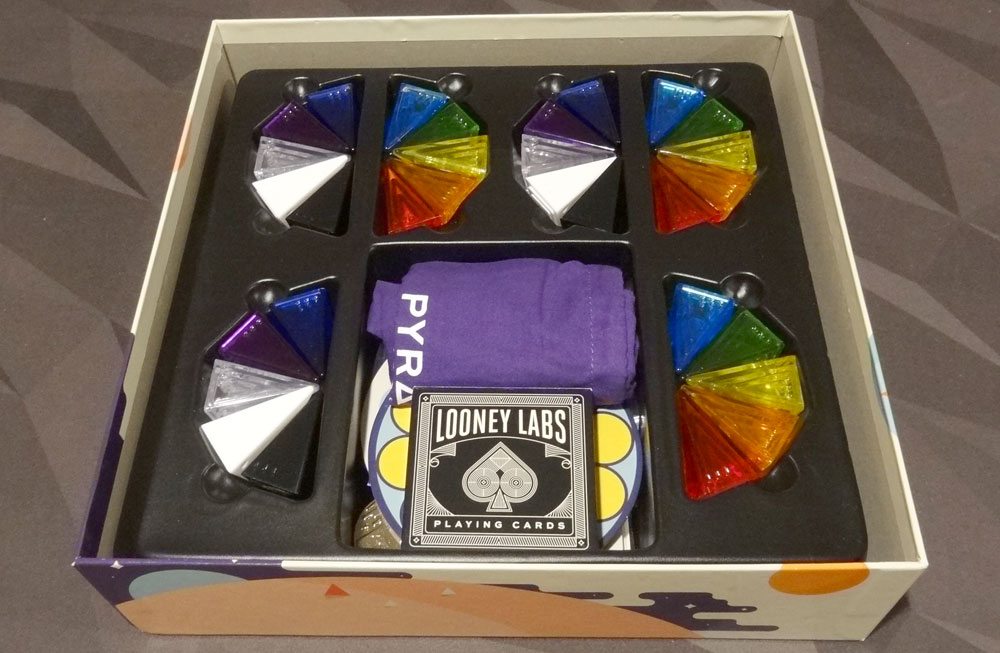
My only complaint about the box and insert design is that there isn’t anything that holds the three larger boards in place, so they just kind of slide around on top, which means that if you tip the box over, some pyramids will probably come out of their spots. Because of the way the pyramids are arranged, the box does have a good deal of oddly-shaped empty space below the tray. Still, none of these are huge complaints, and I love that my Looney Pyramids will now have a nice presentation, rather than the shoebox full of pyramids and accessories I’ve used for so long.
The pyramids themselves haven’t changed significantly from the originals. I described them before in my original Kickstarter alert, but just in case you’re new to them: they’re four-sided plastic pyramids, with an open bottom that allows you to stack or nest them. They come in three sizes (marked with 1, 2, or 3 pips near the base), and can be nested so that each size fits completely inside the next larger size, or you can stack them largest to smallest (forming a “tree”). A set of the three different sizes is called a “trio,” and Pyramid Arcade comes with 3 trios each of 10 different colors: red, orange, yellow, green, cyan, blue, purple, colorless, white, and black. (All of the pyramids are transparent except for the white and black, which are opaque.)
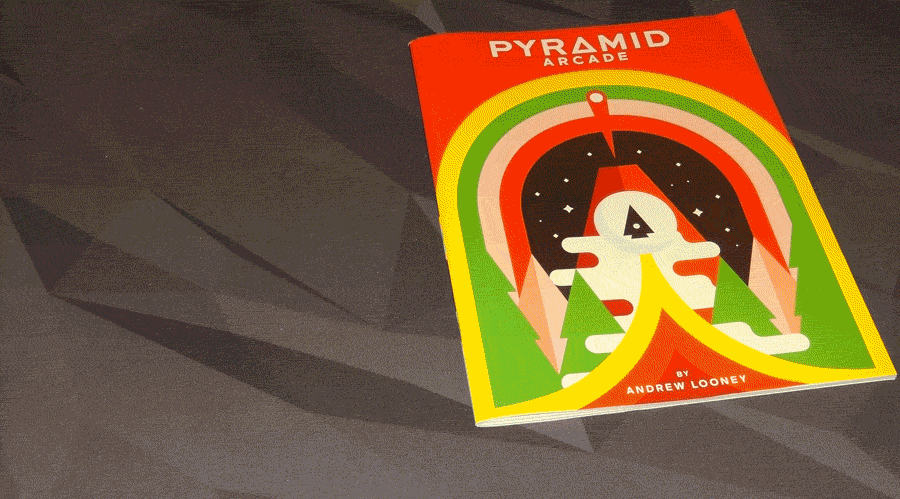
The rulebook is like a magazine, and is big enough that it warrants a Table of Contents. For those who want to dive right in, there’s a “For the Impatient” section right at the beginning. If you’ve got a little more time to read, though, there are explanations of things like simultaneous play, suggestions for younger players, dealing with visibility issues like color blindness or low light, and so on. Each of the rules sections for the games clearly states how many players it takes, along with a rough guide to how long it takes (fast, medium, long) and how complex it is (simple, medium, complex). In the back, you get a brief history of the pyramids, suggestions for inventing your own game, and quick overviews of 22 more games recommended by Starship Captains, the biggest fans of the pyramids. And, finally, there’s a very useful index of games at the back so you can quickly find a game for your preferred number of players, game length, and complexity.
Oh, and on the back cover, there are 24 haikus about the Pyramid Arcade and the 22 games included in the rulebook.
It’s beautifully done and contains so much more than my copy of Playing with Pyramids, and I’m looking forward to reading through all the notes and history. However, since it’s a magazine format, stapled together, I worry that it may fall apart eventually with extensive use, unlike a bound paperback book. Handle with care.
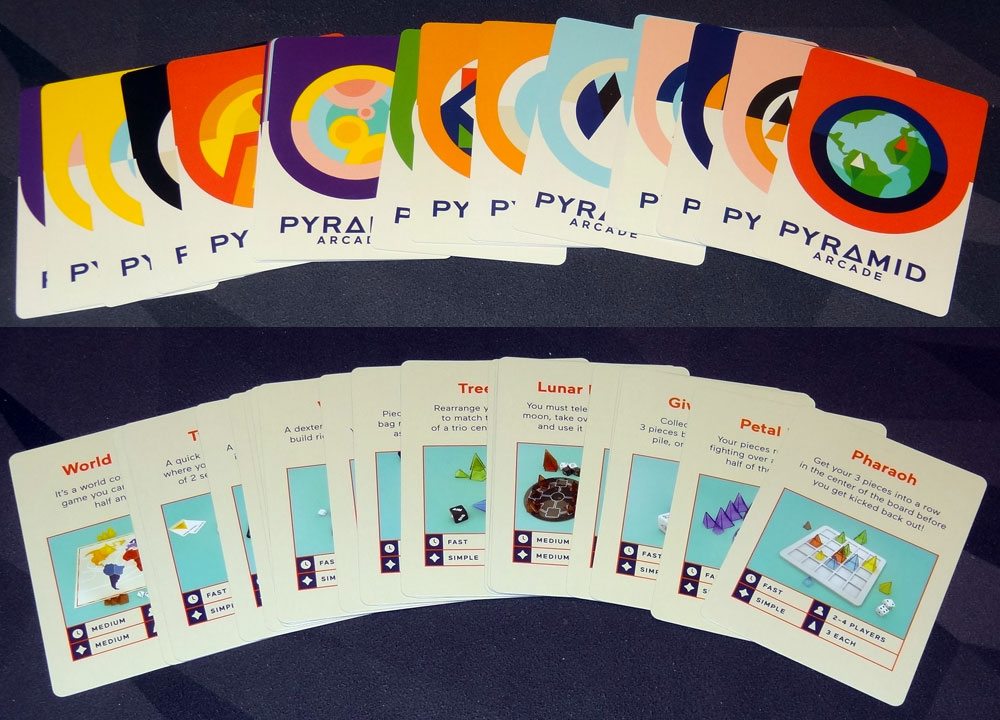
The deck of 22 Pyramid Arcade cards serves the same purpose as the index at the back of the book, but with photos. Each one gives a brief overview of a game, along with its length, number of players, complexity, and number of pyramids required. The backs of the cards have little graphics representing each game. The cards aren’t totally required, but it’s a fun way to pick your next game to play, or for more than one person to be able to look through the available options.

The Twin Win cards are mini cards, and each one shows either a Nest or a Tree of a single color. They’re used for the games Twin Win (of course) and Pyramid-Sham-Bo, but could also be used for other things like randomizing colors.

This deck of cards is referred to as the Zark City deck, since that’s the primary game they were designed for. Zark City is a game that traditionally uses a standard poker deck to build the board as you play—but of course standard cards are rectangular. This is a set of poker cards (with a bonus Star suit) that’s square, so your Zark City blocks can be nice and square. The cards are also used in Verticality, a dexterity stacking game, and they come in their own tuckbox for easy portability in case you want to use them for other traditional card games.
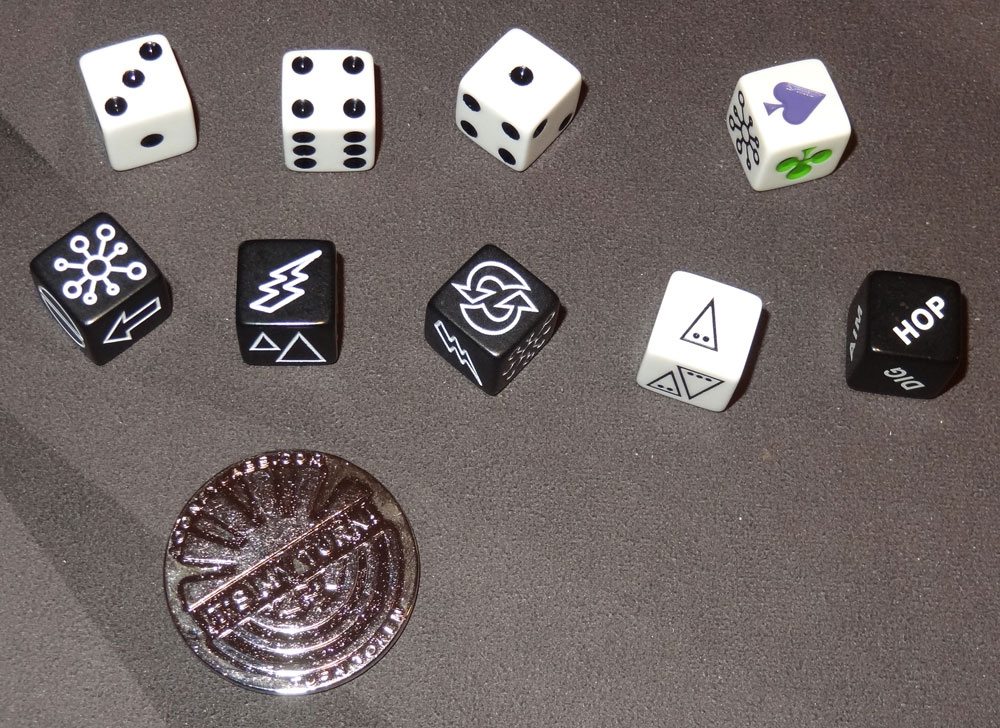
There are 9 six-sided dice included: 3 standard dice, 1 color die, 3 lightning dice, 1 pyramid die, and 1 Treehouse die. The dice are used for various games, and they’re pretty nice: engraved and painted (except for the Treehouse die, which is just printed).
The turn token is a large metal token, embossed with the Pyramid Arcade logo on one side, and “It’s My Turn” with a sunshine/rainbow pattern on the other. While you won’t need it for every game, there are some games in which it’s really helpful to keep track of whose turn it is or who the start player is, and having a big coin to pass around is pretty fun.

On to the boards: the Wheel is a newer component that I hadn’t seen prior to the Pyramid Arcade prototype. It’s a plastic octagonal board with triangular spaces arranged in a wheel. There are only two games listed in the rulebook that use it—Color Wheel and Petri Dish—but it’s such a fun component that I hope more people are creating games that use it.
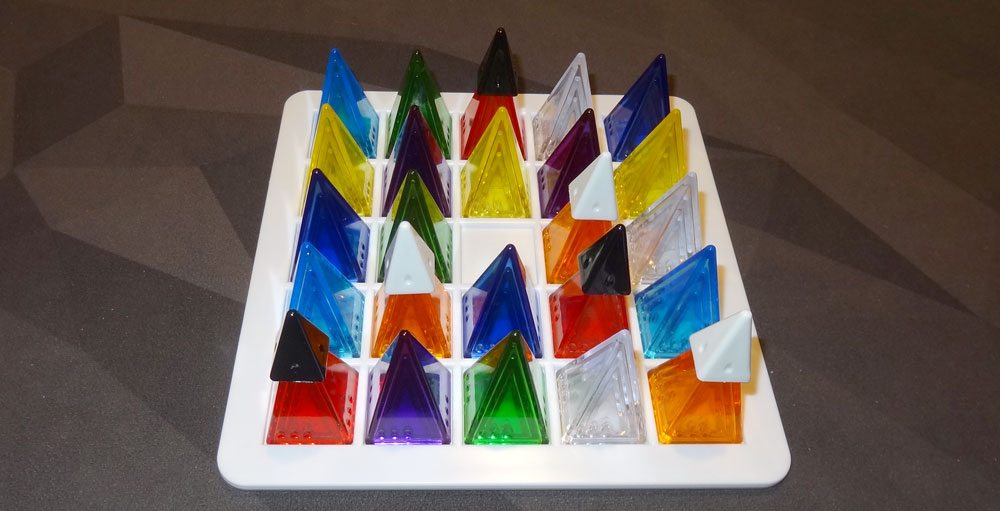
The Volcano board is another white plastic board, this time a square with a 5×5 grid on it. Each square is recessed (like the triangles in the on the Wheel board) to hold a large pyramid nicely in its base. You can, of course, substitute any 5×5 grid (like a selected area of a chessboard) for games that use the Volcano board, but it’s nice to have the wells to hold the pyramids in place. The older incarnation of the Volcano board used a laser-cut acrylic grid affixed to a flat base; this one is a single piece of molded plastic instead.
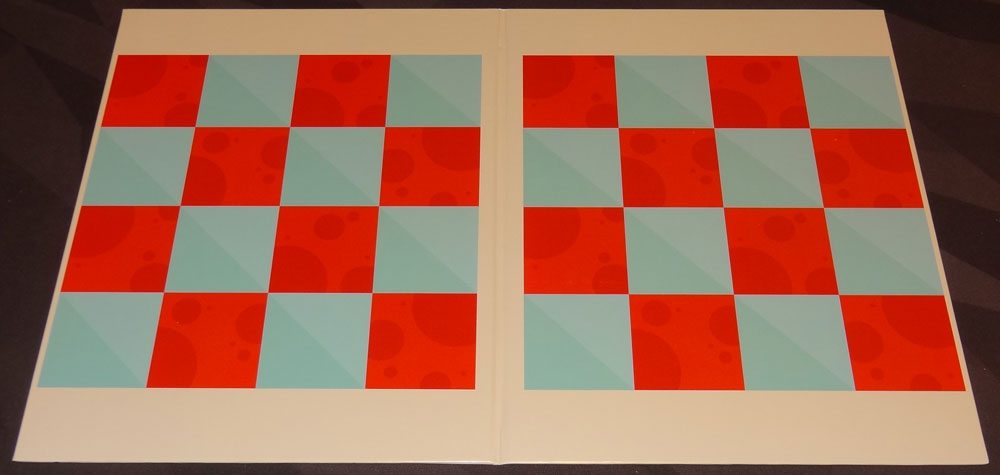
The Martian chessboard is for one of the classic pyramid games, Martian Chess (along with some other games). It’s basically half of a chessboard, though this has a bit of a gap, and the squares are a bit larger than a standard chess board. I’m not entirely sure why they chose to make the half-chessboard rather than the full chessboard, since there are some games (listed in the additional games section) that do require a full chessboard, but I suppose they figure most people have access to a regular chessboard already.
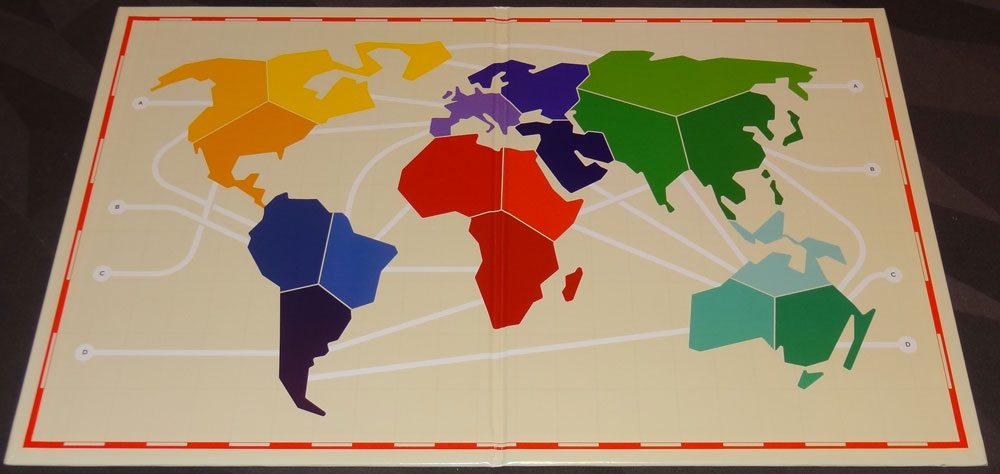
The back of the Martian chessboard is the World War 5 board, used for playing—you guessed it—World War 5, a world-conquest game. (My original WW5 board was simply a tri-fold piece of paper.) It’s funny: I suppose the title World War 5 is at least somewhat optimistic, in that it presumes that humanity survives two more major wars to continue fighting…
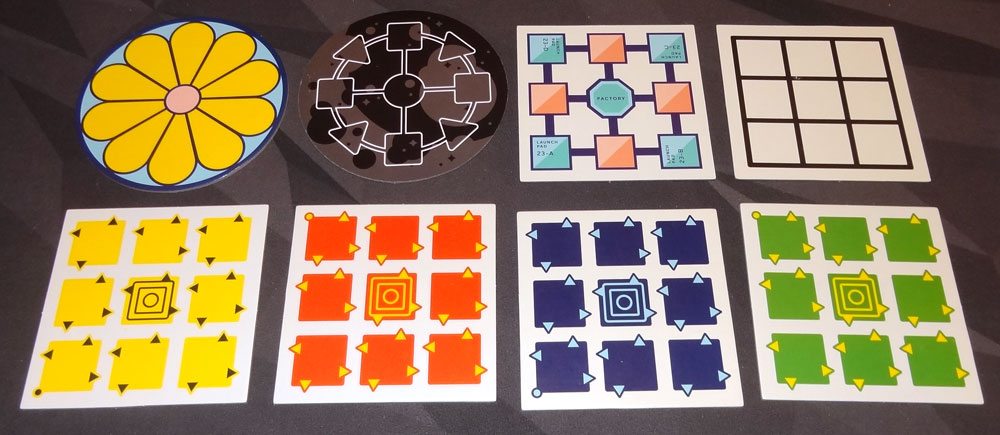
The mini gameboards are a little bigger than coasters—and in fact, many of these boards were originally printed on coasters. Each one is double-sided, though a few of them just have a different color of Looney Ludo (the bottom four shown in the picture) on the back. The gameboards are used for Petal Battle, Launchpad 23, Lunar Invaders, Hijinks, Looney Ludo, and Twin Win.
The cloth bag is nice but not super exciting—just a purple cloth bag for a couple games that involve drawing random pyramids from a bag.
Okay, so that’s all the stuff you get in the box. So what do you do with it?
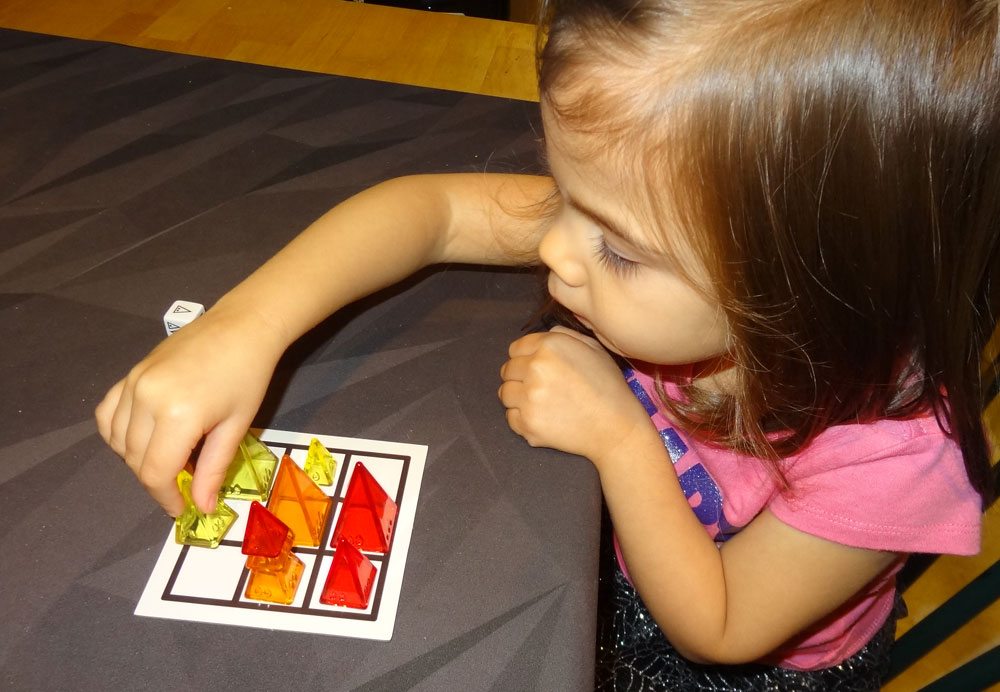
First, of course, there are 22 games in the rulebook. Pyramid Arcade includes all of the bits you’ll need to play any of these games:
- Black Ice
- Color Wheel
- Give or Take
- Hijinks
- Homeworlds
- Ice Dice
- Ice Towers
- Launchpad 23
- Looney Ludo
- Lunar Invaders
- Martian Chess
- Petal Battle
- Petri Dish
- Pharaoh
- Powerhouse
- Pyramid-Sham-Bo
- Twin Win
- Treehouse
- Verticality
- Volcano
- World War 5
- Zark City
Of that list, I’ve probably played about half of the games—many of them were games I’d played before, but a few I learned just this week, playing with my kids. The games are a mix of all sorts of things. There’s a lot of abstract strategy, of course, but also games involving luck, logic, dexterity, and combat. One of my old favorites is Ice Towers, which is one of the first “real-time” tabletop games I’d ever played: there are no turns and everyone plays simultaneously. Homeworlds is one of the most complex games in the bunch—I suppose you’d call it a 4x game, really, because it involves building spaceships and sending them off into space to explore and (potentially) invade other players’ homeworlds. And once you’ve mastered all of those, there are hundreds more to be found: the Icehouse Wiki is a good place to start. Many of these don’t require any specialized equipment other than perhaps a chessboard.
The best thing about Pyramid Arcade is the way that it holds so much potential. It’s like a board gamer’s playground, and the colorful plastic pyramids are inviting to anyone who walks by. My daughters have enjoyed playing with them, both as games and just as toys. If you want to interest your young kids in tabletop gaming, break out a copy of Pyramid Arcade: they won’t be able to resist. And if you’re an aspiring board game designer yourself, the multitude of components in this box make for a fantastic prototyping set.
Pyramid Arcade was released November 3—ask for it at your local game store, or check the Looney Labs website for store locators and their own online store.
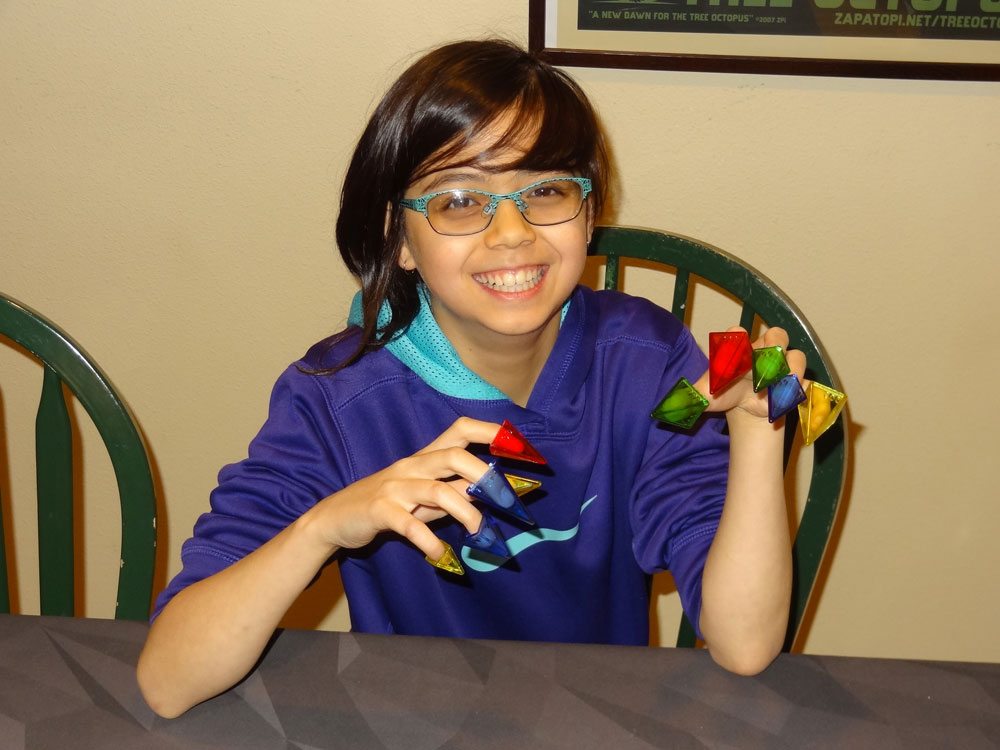
Review sample provided by Looney Labs.


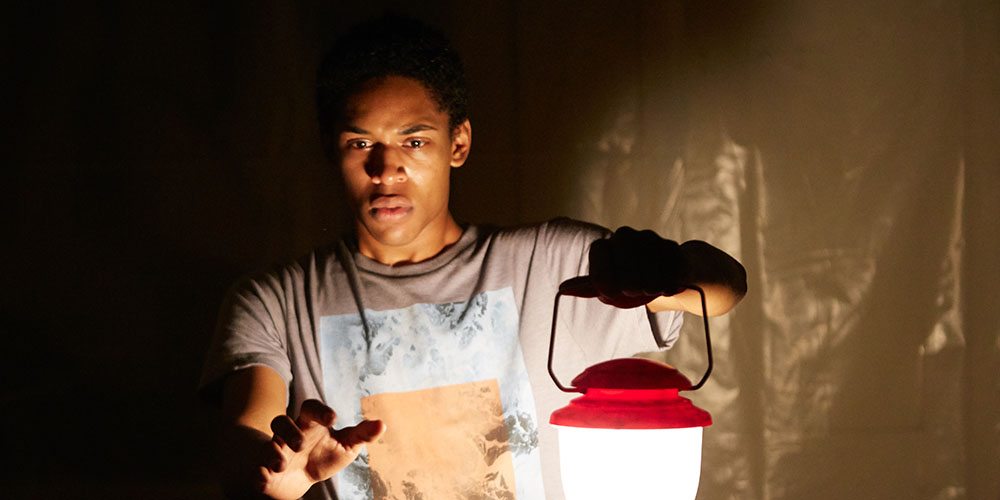
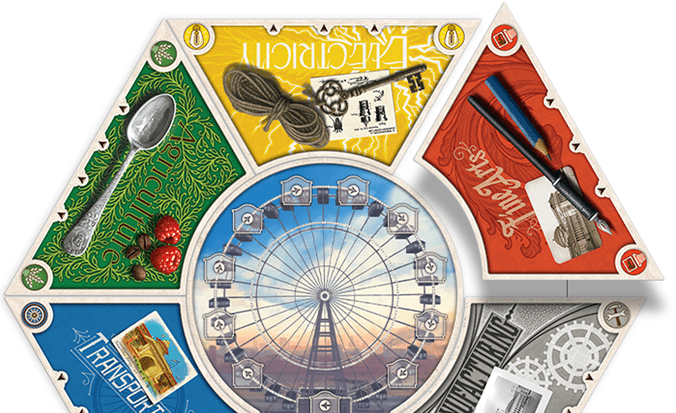

Hello Johnathan. I just wanted to say that I enjoyed reading your article and I am looking forward to receiving my copy of pyramid arcade in the near future.
Thanks for this review! Trying to decide if can afford to buy it, I did almost back it in kick-start er because I love fluxx 🙂